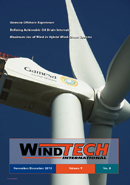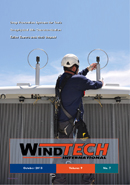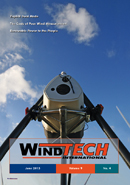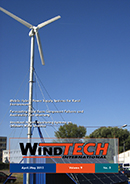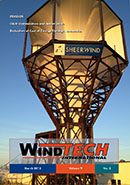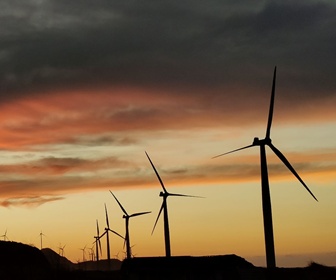- Category: 2013
The Front CoverThe first offshore G128-5.0MW prototype is inaugurated in Spain (at the Arinaga quay in Gran Canaria, Canary Islands) and was commissioned before summer. On page 6 you can read more about this turbine and Gamesa’s offshore turbine development strategy.Publisher's NoteThe European Offshore MarketFeatures
Gamesa Offshore Experience |
|
- Category: 2013
The Front CoverWhile there are federally mandated guidelines in the USA for securing people working on surfaces 4 feet (1.22 metres) or more from the ground, there are no such requirements for securing tools. In the article on page 6, John Martell discusses why organisations need to implement some type of tethered tool programme in the interests of safety. The image on the cover shows a technician who stands outside on top of a nacelle using tethered tools to adjust a wind sensor on a wind turbine. Publisher's NoteFeatures
|
Supported by: |
- Category: 2013
The Front CoverThe Windvogel is a cooperative association in the Netherlands whose goal is the promotion and generation of renewable energy. It contributes to this by building new wind turbines, by purchasing and operating existing turbines, and by installing solar photovoltaic units. The cooperative has now launched the idea of creating a sustainable energy supply for all Dutch citizens using a thousand 7.5MW wind turbines. (image courtesy Windvogel) Publisher's NoteFeatures
|
Supported by: |
- Category: 2013
The Front CoverThe term ‘agile positioning’ may have been coined recently by The Switch to refer to its way of responding to market change. But ‘lean start-up methodology’, which is very similar in its approach, has been practised by many companies. In the article on page 6, Mr Kurttila explains ‘agile positioning’ and how The Switch has used this concept to refine its business model. Publisher's NoteFeatures
|
Supported by: |
- Category: 2013
The Front CoverThe very first practical use of wind lidar by ZephIR occurred in 2003, with the system deployed on a Nordex turbine performing measurements upwind from the nacelle. In order to verify its performance claims, ZephIR Lidar embarked on a ten-year research programme to illustrate the performance attributes when compared to more traditional techniques, such as tall meteorological (met) masts and even wind tunnels used to calibrate cup anemometers themselves. Ten years on, and ZephIR’s continuous-wave (CW) lidar technology continues to be developed and is now gaining increasing acceptance in its original application of optimising wind turbine generator performance. Publisher's NoteFeatures
|
Supported by: |
- Category: 2013
The Front CoverAn energy container is a mobile hybrid power supply system built into a container. Much of the past use and development of energy containers has been for military purposes, but they can also be used for civilian purposes. In the article on page 6 the author presents an overview of the capabilities, market and applications of energy containers, with particular emphasis on the role of the wind turbines to be found within them. Publisher's NoteFeatures
|
Supported by: |
- Category: 2013
The Front CoverThe image on the front cover shows a commercial-scale INVELOX commissioned in Chaska, Minnesota, USA, in November 2012. The INVELOX wind technology, developed by the American company SheerWind, is providing an effective alternative to conventional propeller-driven wind-harvesting systems. On page 6 you can read the full article about this new development. Publisher's NoteFeatures
|






